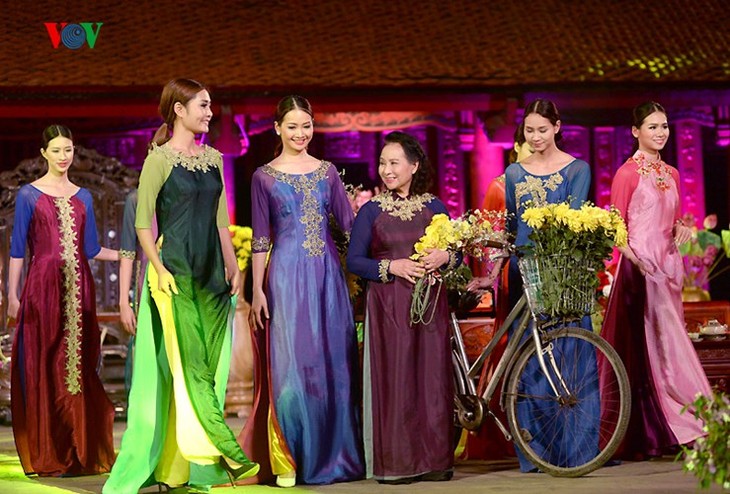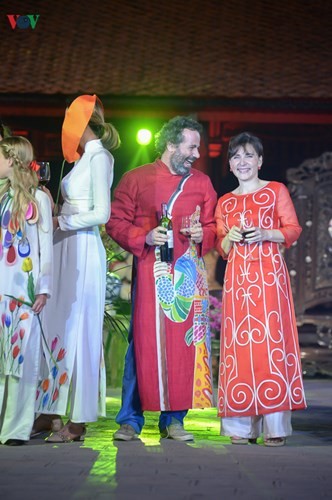(VOVworld) - The fever of spring and Tet, the Vnese Lunar New Year, has arrived. From February to April, Hanoi is humid and wet with frequent drizzles. The temperature ranges from 15 to 20 DC. Because this weather encourages plants to bud and flowers to blossom, spring is the best time for tourists to witness the vitality of Vietnam’s tropical nature.
B: The spring season sees a host of festivals in northern Vietnam, where visitors can stroll among the blossoming spring flowers and see the country at its best. At folk festivals, tourists can learn about the culture of Vietnam’s different regions.
A: Starting as early as February, the cold winds and freezing temperatures of winter begin to subside as spring draws near in northern Vietnam. But Vietnam’s central and southern regions are suffering worse than usual from drought and saline intrusion.

Drought and saline intrusion in Vietnam's central region and part of the Mekong Delta |
B: It’s sad to see the visible impact of climate change on people’s lives. Experts say parts of the Mekong Delta in Vietnam are experiencing the worst drought and saltwater encroachment of the past 100 years. This has seriously damaged rice and fruit growing areas and forests, and crated freshwater shortages. The Ministry of Agriculture and Rural Development estimates that the delta needs some 4 billion USD to deal with the drought and saltwater encroachment.
A: This week we received good news from Gerry Neumann of England. He has booked a ticket to come to Vietnam in early May, during which time he’ll make a point of coming to Hanoi and hopefully to the VOV studios in Ba Trieu street, Gerry said.
B: Wow, that’s great. We can hardly wait to meet Gerry again. It’s been years. Gerry reported listening to programs in March and said reception in the south of England on 5955 KHz at 18UTC continues to be good. He says he still has trouble sometimes, though, when it comes to pronouncing Vietnamese names.
 |
A bird-view of Hue city and Truong Tien bridge
|
B: Sorry, Gerry, if we pronounce the Vietnamese names too quickly or unclearly. We’ll try to pay more attention to pronouncing Vietnamese names. If you ask Vietnamese people about learning Vietnamese, many of them will say Vietnamese is hard. It can be discouraging for new learners.
A: It’s true that, with six tones and a plethora of strange vowel sounds that don’t exist in English, pronouncing Vietnamese can be tricky. But many expats in Vietnam fail to realise that the pronunciation is just about the only difficult thing about Vietnamese. Other aspects of the language are extremely easy – far easier that what you might expect, especially compared to European languages.
B: Really? Tell me more.
A: Vietnamese has no genders. Vietnamese has no concept of “masculine” or “feminine” words. Vietnamese also dispenses with “a” and “the” For example "người” can either mean “a person” or “the person”, and you never need to worry about the distinction. Vietnamese doesn’t have plural forms. If you want to specify more than one of a noun, you just put a word in front of the noun, such as many, some, all, or a number.
B: You should be a teacher of Vietnamese.
A: Thank you. That’s just some tips for learning conversational Vietnamese. Pronouncing the words correctly requires steady practice. Now let’s continue with Gerry Neumann’s email: “My most recent listening was on Saturday 5th March when the reception on 5955 KHz was SINPO 45444 for the most part. After the domestic and foreign news segment, the Saturday Report was about a group of 20 children from the H’Mong ethnic minority who took part in a musical.”
 |
| Books about learning Vietnamese for foreigners |
A: Gerry continued: “The last part of the program was the Weekend Music Show which featured 2 songs from an album called ‘Dream of the Homeland’ about the Central regions, sung by a woman from that region, Pham Phuong Thao. The first song was about the people of that region. Unfortunately, the transmission from the relay station stopped in the middle of the song until the end of the broadcast.” Later in the evening Gerry tuned in at 20:30 UTC and managed to hear the second song by Thao, about a bridge over a river in Quang Tri province.
B: Gerry continued: “I do enjoy the varied styles of music that VOV plays, not only on Saturdays, but also at the end of some weekday broadcasts – in addition to all the other features that bring us information and news!”
A: It’s our intention to have at least one song in each program. It’s a treat after listening to the news about politics, economics, and society. Gerry noted: “Reception on March 5th at 20:30 UTC on 7280 KHz was 21441 – with very strong interference from China Radio International, also in English on the adjacent frequency of 7285 KHz, which made listening impossible. Reception was slightly better on 9730 KHz with SINPO 35433.”
 |
An Ao dai collection themed "Orchids" by designer Vu Viet Ha
|
B: Thank you very much for your detailed information. We hope to receive more remarks from you and other listeners which help our technicians monitor our overseas broadcast. From the US Richard Nowak emailed us to say: “I enjoyed the wonderful show tonight on 6175 kHz from 1:00 to 1:27 UTC listening with a 1941 Hallicrafters SX-28 hooked up to an off center fed dipole with an overall length of 41 meters. Reception was great. Signal=5, Interference=5, Noise=5, Propagation=4. Overall=4.5, great reception.” He also attached an audio clip of the program.
A: Richard commented about the content: “Cultural and Sporting Events mentioned International Women's Day, a festival honoring Vietnamese traditional dress. The festival sounds nice. The great Sunday Show had an interesting segment on traditional Thai headscarves, taking the leaf of a palm, and dyeing fabrics, and a beautiful song about headscarves was played. Embroidering and facts such as a headscarf being buried with its owner were mentioned. Facts like these make these segments interesting.”
 |
Italian Ambassador wears an Ao dai in designer Chu La's collection themed "Tulip"
|
B: Thanks for the great show and your support for shortwave, Richard said. His report was detailed and we’ll verify it soon. I’m reading a letter from Muneer K.P Sharjah of the UAE who listened to our program on February 23, 2016. It was on the frequency of 7220 khz, at 16:01 UTC. Using a Sony SW-11 with long wire antenna, he rated the conditions excellent with a SINPO rating of 55444.”
A: Hubert Wilczyński, a radio enthusiast in Poland, listened to our programs and said it was a great opportunity to learn about Vietnam’s culture and beautiful country. He said the program on March 7, on the frequency of 7280 khz at 20:30 UTC was good with SINPO at 54434 on his Tecsun s-2000 receiver. There was slight interference from CRI 7295 kHz, Hubert said.
A: Thank you very much for your reception reports, listeners. Please feel free to send us your feedback. Our address is English Section, Overseas Service, Voice of Vietnam, 45 Ba Trieu Street, Hanoi, Vietnam. Our email address is englishsection@vov.org.vn. Thank you for listening. Come back again next Wednesday for another Letter Box show. Goodbye from both of us to all of you.